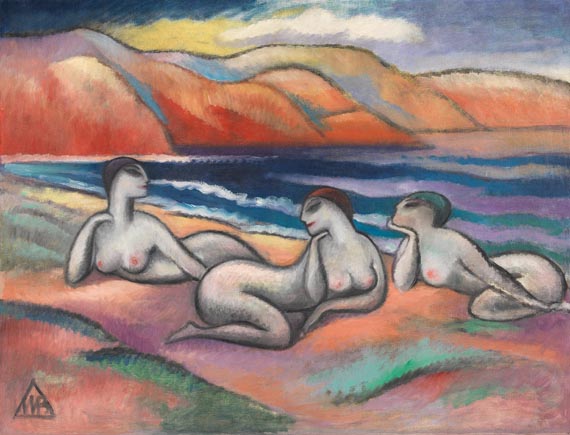
48
Wladimir Georgiewitsch von Bechtejeff
Reptilien, 1911.
Oil on canvas
Estimate:
€ 250,000 / $ 295,000 Sold:
€ 378,200 / $ 446,276 (incl. surcharge)
Oil on canvas
Monogrammed "WB" (in a triangle) in lower left. 65 x 85 cm (25,5 x 33,4 in)
PROVENANCE: Julius Martin, Munich 1912.
Gerta Martin-Zweifel.
Setty Martin, Zurich.
Private collection Switzerland.
EXHIBITION: Neue Künstlervereinigung München, III. exhibition, Moderne Galerie Thannhauser, Munich, 18 December 1911 - 1 January 1912. Cat. no. 6a (with adhesive label on stretcher).
LITERATURE: Annegret Hoberg/Helmut Friedel, Der Blaue Reiter und das Neue Bild. Von der Neuen Künstlervereinigung München zum Blauen Reiter, Städtische Galerie im Lenbachhaus, München, 2 July - 3 October 1999, p. 362 (reproduction of the exhibition catalog of the 3rd exhibition of the Neue Künstvereinigung München.
After completing his training at the Military Academy in Moscow, Vladimir Bechtejeff started to study painting at the Moscow Academy of Arts in 1902. On the advice of Jawlensky, he moved to Munich the same year, where he continued his studies with Heinrich Knirr until 1905. From 1906 to 1909, Bechtejeff lived in Paris. Returning to Munich, he joined the 'Neuen Künstlervereinigung München' (New Munich Artists Association) in 1909.
Stylistic approaches to almost all tendencies in art of his days can be observed in the works by Wladimir Bechtejeff. Formally stuck with the symbolic elements of late Art Deco, he created his own sensual-decorative world of images, which also took on elements from Expressionism with its intensive coloring. Bechtejeff, whose strong interest in expressive dancing is reflected in the depiction of people in his paintings, was a good friend of the dancer and choreographer Alexander Sacharoff. However, another component may not be overlooked in our interesting composition, either. The time this work was made was a period in which a new female self-concept arose, as women had previously rather been regarded as ‘servants‘ or mothers. But these were the days a new type of woman was discovered, the strong woman that is in control. Whether Salomé or Lulu, it was the woman that seduced the man and that would even fancy taking an obviously wrong direction. The three intriguing ‘Reptilien‘ (Reptiles), obviously women, are fully aware of their mysterious powers. Their sensual appeal gives them both an air of seduction and destruction. The title Bechtejeff chose for this work should also be understood in this sense.
He left the ‘Neue Künstlervereinigung München‘ again in 1912 in protest against a self-publicising attack by the group on abstract painting. Subsequently, he produced ornamentally flat compositions with an energetic color rhythm which nonetheless retain figurative references. With the start of the World War I, Bechtejeff's artistic development broke off abruptly. He returned to Russia and was called up for military service immediately. Afterwards Bechtejeff initially worked in the Moscow Commission for the Preservation of Historical Monuments, and then, in the years 1921/22, as a stage builder, later becoming Design Manager of the Moscow State Circus. In the 1920s and 1930s, he mainly worked as an illustrator. In his later works he devoted himself to watercolors and gouache, in addition to oil painting. Bechtejeff was accorded increasing recognition in his own country after the end of the Stalinist defamation.
48
Wladimir Georgiewitsch von Bechtejeff
Reptilien, 1911.
Oil on canvas
Estimate:
€ 250,000 / $ 295,000 Sold:
€ 378,200 / $ 446,276 (incl. surcharge)
Headquarters
Joseph-Wild-Str. 18
81829 Munich
Phone: +49 89 55 244-0
Fax: +49 89 55 244-177
info@kettererkunst.de
Louisa von Saucken / Undine Schleifer
Holstenwall 5
20355 Hamburg
Phone: +49 40 37 49 61-0
Fax: +49 40 37 49 61-66
infohamburg@kettererkunst.de
Dr. Simone Wiechers / Nane Schlage
Fasanenstr. 70
10719 Berlin
Phone: +49 30 88 67 53-63
Fax: +49 30 88 67 56-43
infoberlin@kettererkunst.de
Cordula Lichtenberg
Gertrudenstraße 24-28
50667 Cologne
Phone: +49 221 510 908-15
infokoeln@kettererkunst.de
Hessen
Rhineland-Palatinate
Miriam Heß
Phone: +49 62 21 58 80-038
Fax: +49 62 21 58 80-595
infoheidelberg@kettererkunst.de
We will inform you in time.




 Lot 48
Lot 48 